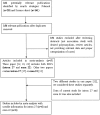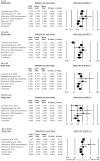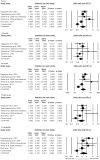Complement receptor 1 variants confer protection from severe malaria in Odisha, India
- PMID: 23152904
- PMCID: PMC3496672
- DOI: 10.1371/journal.pone.0049420
Complement receptor 1 variants confer protection from severe malaria in Odisha, India
Abstract
Background: In Plasmodium falciparum infection, complement receptor-1 (CR1) on erythrocyte's surface and ABO blood group play important roles in formation of rosettes which are presumed to be contributory in the pathogenesis of severe malaria. Although several studies have attempted to determine the association of CR1 polymorphisms with severe malaria, observations remain inconsistent. Therefore, a case control study and meta-analysis was performed to address this issue.
Methods: Common CR1 polymorphisms (intron 27 and exon 22) and blood group were typed in 353 cases of severe malaria (SM) [97 cerebral malaria (CM), 129 multi-organ dysfunction (MOD), 127 non-cerebral severe malaria (NCSM)], 141 un-complicated malaria and 100 healthy controls from an endemic region of Odisha, India. Relevant publications for meta-analysis were searched from the database.
Results: The homozygous polymorphisms of CR1 intron 27 and exon 22 (TT and GG) and alleles (T and G) that are associated with low expression of CR1 on red blood cells, conferred significant protection against CM, MOD and malaria deaths. Combined analysis showed significant association of blood group B/intron 27-AA/exon 22-AA with susceptibility to SM (CM and MOD). Meta-analysis revealed that the CR1 exon 22 low expression polymorphism is significantly associated with protection against severe malaria.
Conclusions: The results of the present study demonstrate that common CR1 variants significantly protect against severe malaria in an endemic area.
Conflict of interest statement
Figures



Similar articles
-
CR1 levels and gene polymorphisms exhibit differential association with falciparum malaria in regions of varying disease endemicity.Hum Immunol. 2009 Apr;70(4):244-50. doi: 10.1016/j.humimm.2009.02.001. Epub 2009 Feb 10. Hum Immunol. 2009. PMID: 19480840
-
CR1 exon variants are associated with lowered CR1 expression and increased susceptibility to SLE in a Plasmodium falciparum endemic population.Lupus Sci Med. 2016 Nov 14;3(1):e000145. doi: 10.1136/lupus-2016-000145. eCollection 2016. Lupus Sci Med. 2016. PMID: 27933195 Free PMC article.
-
High CR1 level and related polymorphic variants are associated with cerebral malaria in eastern-India.Infect Genet Evol. 2011 Jan;11(1):139-44. doi: 10.1016/j.meegid.2010.09.009. Epub 2010 Oct 14. Infect Genet Evol. 2011. PMID: 20951238
-
Complement receptor 1 genetic polymorphism contributes to sporadic Alzheimer's disease susceptibility in Caucasians: a meta-analysis.Biosci Rep. 2020 Jun 26;40(6):BSR20200321. doi: 10.1042/BSR20200321. Biosci Rep. 2020. PMID: 32432316 Free PMC article. Review.
-
Complement receptor 1 and malaria.Cell Microbiol. 2011 Oct;13(10):1441-50. doi: 10.1111/j.1462-5822.2011.01648.x. Epub 2011 Aug 24. Cell Microbiol. 2011. PMID: 21790941 Review.
Cited by
-
Differential positive selection of malaria resistance genes in three indigenous populations of Peninsular Malaysia.Hum Genet. 2015 Apr;134(4):375-92. doi: 10.1007/s00439-014-1525-2. Epub 2015 Jan 30. Hum Genet. 2015. PMID: 25634076
-
Diagnosis of cerebral malaria: Tools to reduce Plasmodium falciparum associated mortality.Front Cell Infect Microbiol. 2023 Feb 9;13:1090013. doi: 10.3389/fcimb.2023.1090013. eCollection 2023. Front Cell Infect Microbiol. 2023. PMID: 36844403 Free PMC article. Review.
-
Haplotype of RNASE 3 polymorphisms is associated with severe malaria in an Indian population.Mol Biol Rep. 2020 Nov;47(11):8841-8848. doi: 10.1007/s11033-020-05934-1. Epub 2020 Oct 28. Mol Biol Rep. 2020. PMID: 33113080 Free PMC article.
-
Association of IL13 polymorphisms with susceptibility to myocardial infarction: A case-control study in Chinese population.PLoS One. 2024 Aug 1;19(8):e0308081. doi: 10.1371/journal.pone.0308081. eCollection 2024. PLoS One. 2024. PMID: 39088580 Free PMC article.
-
MBL-2 polymorphisms (codon 54 and Y-221X) and low MBL levels are associated with susceptibility to multi organ dysfunction in P. falciparum malaria in Odisha, India.Front Microbiol. 2015 Jul 31;6:778. doi: 10.3389/fmicb.2015.00778. eCollection 2015. Front Microbiol. 2015. PMID: 26284055 Free PMC article.
References
-
- WHO (2011) World Malaria Report 2011.
-
- Pattanaik SS, Tripathy R, Panda AK, Sahu AN, Das BK (2012) Bacteraemia in adult patients presenting with malaria in India. Acta Trop. - PubMed
-
- Brown H, Hien TT, Day N, Mai NT, Chuong LV, et al. (1999) Evidence of blood-brain barrier dysfunction in human cerebral malaria. Neuropathol Appl Neurobiol 25: 331–340. - PubMed
Publication types
MeSH terms
Substances
LinkOut - more resources
Full Text Sources

